a very belated account of kate and duffy's time in mysore

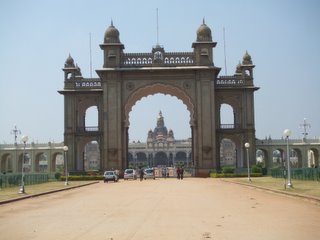
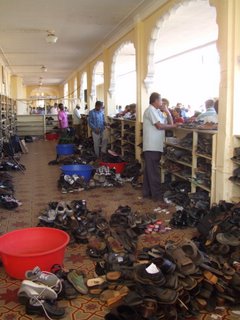
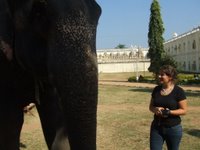
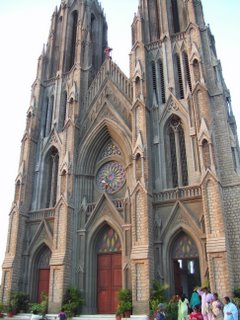
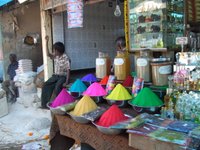
 We were in Mysore from Friday, January 27th until Sunday, January 29th. The bus from Ooty to Mysore was fascinating. After numerous switchbacks and several very sharp turns, near head-on collisions, and more than one occasion where the bus had to back up to avoid on-coming buses, we were out of the mountains and into much more level terrain. While dangerous, the mountain roads were also very interesting. We were able to get another look at the endless rubber and teak plantations, hillside, terraced farming, and large tracts of land that were, for some reason, being burned. Irrigation in the hills near Ooty is unique. Instead of sprinklers, teams of men using a fire hose were common sights from the bus windows.
We were in Mysore from Friday, January 27th until Sunday, January 29th. The bus from Ooty to Mysore was fascinating. After numerous switchbacks and several very sharp turns, near head-on collisions, and more than one occasion where the bus had to back up to avoid on-coming buses, we were out of the mountains and into much more level terrain. While dangerous, the mountain roads were also very interesting. We were able to get another look at the endless rubber and teak plantations, hillside, terraced farming, and large tracts of land that were, for some reason, being burned. Irrigation in the hills near Ooty is unique. Instead of sprinklers, teams of men using a fire hose were common sights from the bus windows. The “road” to Mysore amounted to 2 tire tracks in several places and many times road work was symbolized not by bright orange and white barricades, but by a simple pile of boulders making that section of the road impassable. Luckily, our trip went through several wildlife refuges, so we were able to see elephants, peacocks, monkeys, wild boars fighting with monkeys, and deer. After sunset, however, the road became more boring than interesting, with the exception of the nearly constant stream of carts pulled by teams of oxen. We arrived in Mysore at around 8:00 pm, took an auto rickshaw directly to a hotel with much needed hot showers, room service and an excellent restaurant that would become like a second home for the next 2 days.
Mysore’s basic attractions are a large, relatively new palace, large market area, and cathedral. We decided that our first stop would be the palace. The amba vilas palace was built in 1897 for the wodeyar monarchs. The palace grounds are large and open, with several parks, plazas, and temples. The main building is a massive series of reception halls and throne rooms, each lined with paintings, floors of marble, and massive stained glass ceilings and windows. Every surface is covered in bright blue, red, green, and gold paint. One of the more interesting features of the palace grounds is that visitors need to remove their shoes. Since there are hundreds of visitors at any one time, the check room for shoes is one of the more unique and chaotic scenes I’ve ever witnessed. The grounds are also home to two elephants and two camels. And what could be better than riding an elephant around the former maharaja’s palace? The ride was only about 10 minutes, but it was a lot of fun. Somehow, elephants are even bigger than you imagine them to be.
After several hours of wandering the palace, and a delicious pizza lunch, we headed to the north side of town to visit the cathedral. As we headed towards the cathedral, we noticed more and more women in Islamic dress, mosques, and other signs of a Muslim community. We were nearly convinced that we were lost, when suddenly two massive spires appeared in front of us. It turned out that the cathedral was right in the middle of a predominately Muslim area. Another encouraging sign of India’s diversity.
The church was the most tourist-oriented one I have ever seen. There was a brief synopsis of the Catholic faith on the inside front wall, and placards to explain each aspect of a cathedral were placed all over. There were several large shrines and a grotto outside, but the most interesting sign was a two-part history of the world according to the Bible, from Genesis to some future time labeled “Eternity”. It was interesting to see the entirety of Christian past, present, and future neatly arranged on two flowcharts. We left the cathedral shortly before sunset since we had a long walk back and Kate had recently notice several wasp nests a few yards long near the tops of the stained glass windows.
The next day, we headed into the market. I’m not sure what your vision of India is, but mine involves lots of smells from different spices, incense, and flowers, endless rows of stalls selling fruits, nuts, beads, and basically anything else people try to trade, and, of course, elephants. A very Marco Polo-type vision, and we found it in the Mysore market. As soon as we entered the market, we walked past an endless corridor of onions, bananas, and oranges on one side and row after row of vendors selling powder that could be mixed into paint on the other. After wandering around for about 10 minutes with our jaws on the ground and our eyes wide open, a young man began to talk to Kate and next thing we knew, we were at his incense and oil stall. He claimed that he had handmade incense sticks and we, being the shrewd customers we are, were immediately skeptical. He seemed to sense this and told us to come behind the counter where he proceed to sit down at a cutting board and make incense by mixing a paste of gum wood and water, rolling it out, wrapping it around a stick, and sprinkling it with essential oil mixed with colored dust. Needless to say, we were impressed. We bought a few bottles of scented oil each, figuring that in Wuhan, we would need all the good smells we could get, and were about to leave when the salesman thanked us and started handing us about 100 free incense sticks. We also proceeded to buy cinnamon, cloves, curry, masala mix, and a few other spices. It was one of the most memorable mornings of our time in India.
After lunch we headed outside the city to one of the “7 most scared hills in Southern India.” As we’ve said, southern India has a lot of hills, so we thought this one must be pretty impressive to be ranked that high. The view of Mysore was impressive, and reminded us of the fact that while India doesn’t have high rises, it still has a lot of residents. From the top of the hill, all we could see in every direction was city. Our fascination with the view was quickly ended, however, by a passing group of monkeys. A monkey that is 10 feet away is usually much better at holding attention than a landscape.
That night we left Mysore, but not before heading over to the palace one more time. Our friend at the fragrance shop had informed us that at 7:00 that night, all the lights at the palace would be turned on. This interested us greatly, because we had noticed the day before that the palace had more light bulbs than a mid-sized airport. Just before getting on the bus to Hospet, we lugged our packs to the palace just in time. At 7:01, the entire palace started to glow. It was amazing. The grounds around the palace were basically cast in daylight. With that encouraging sight, we shouldered our packs and headed to the bus station for another tooth-shattering night on the road.
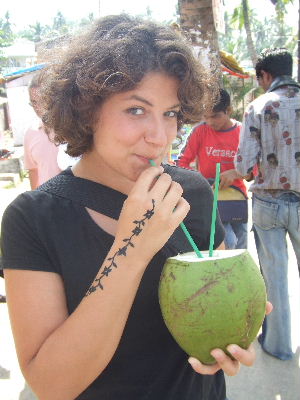

1 Comments:
Duff, enjoyed this posting greatly...always interested in the terrain...when the bus came up and the terrain levelled out, do you know what you altitude was?...Market experience is a great read...and those hills, just what are they scared about? Actually, I can relate to the "scared" vs "sacred" thing...on more than a few occasions in court I have referenced various "statues" (vice "statutes")leading some judges to exhibit puzzled faces.
7:10 PM
Post a Comment
<< Home